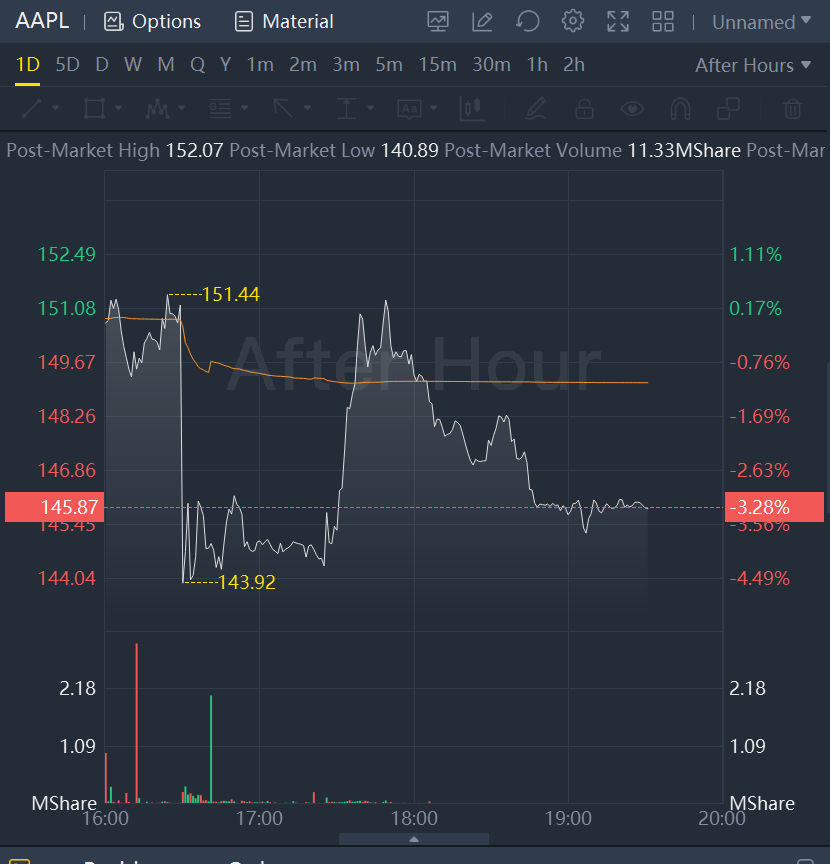Apple Inc.'s business came under pressure in the holiday quarter, as the company posted a 5% decline in revenue amid underwhelming sales of iPhones, Macs and wearables.
Apple's iPhone revenue fell to $65.8 billion in the fiscal first quarter from $71.6 billion a year before, whereas analysts tracked by FactSet were looking for $67.8 billion. The performance comes after Apple warned in November that its iPhone 14 Pro and Pro Max shipments would be impacted by pandemic-fueled production constraints at a major Foxconn facility in China.
After reporting a quarterly revenue record for Macs in the September quarter, Apple fell way short of those heights in the December quarter with its Thursday afternoon report, and the company missed expectations by a wide margin. Mac sales declined to $7.7 billion from $10.9 billion a year earlier, while analysts had been looking for $9.4 billion.
Those big misses helped drive total revenue lower on the year and fueled a miss on the top line, despite a sizable beat in the iPad category a year prior, while the FactSet consensus was for $121.4 billion.
Dating back to its report for the December 2017 quarter, Apple has only missed revenue expectations twice, according to FactSet, including one time when the company issued a formal warning ahead of its official results.
Apple shares $(AAPL)$ were down 3.28% in after-hours trading Thursday.
Apple's profits fell as well in the latest period, as the company generated net income of $30.0 billion, or $1.88 a share, compared with $34.6 billion, or $2.10 a share, a year earlier. Analysts were modeling $1.94 in earnings per share.
Within its iPad segment, Apple showed sharp growth. Revenue increased to $9.4 billion from $7.3 billion a year earlier. The FactSet consensus was for $7.8 billion.
Revenue for wearables, home and accessories came in at $13.5 billion, down from $14.7 billion a year before and far below the $15.3 billion that analysts were modeling. Services revenue rose to $20.8 billion from $19.5 billion and beat the FactSet consensus, which was for $20.4 billion.
The results were consistent with the "cautious" expectations that Wells Fargo analyst Aaron Rakers had ahead of the report, he wrote in a note to clients.
One focus on the earnings call later Thursday will be how Apple is managing expenses in a tougher economic climate. While Chief Executive Tim Cook said in November that Apple was being "very deliberate" with its hiring, other big technology companies, including Amazon.com Inc. $(AMZN)$ and Alphabet Inc. $(GOOGL)$(GOOGL), have since moved to lay off workers.
Investors will also want to know how consumer spending is holding up in a weaker economic climate, and whether Apple executives expect to be able to make up for iPhone sales lost during the period when the company was seeing supply constraints.
Wall Street will "have to wait for the guide here, but the question will be 'how much of the revenue miss was driven by production issues in China and how does that ramp up into the March [quarter] and beyond?'" Evercore ISI analyst Amit Daryanani wrote in a note.
Apple didn't provide a forecast in its statement, as has been the case throughout the pandemic. The company typically provides some sort of future commentary on its earnings call, though it hasn't been offering traditional guidance since the pandemic began.
Shares of Apple have fallen 14.2% over the past 12 months, though they're up 16.1% to start 2023. The Dow Jones Industrial Average is off 4.4% over a 12-month span but ahead 2.7% so far this year.

Comments